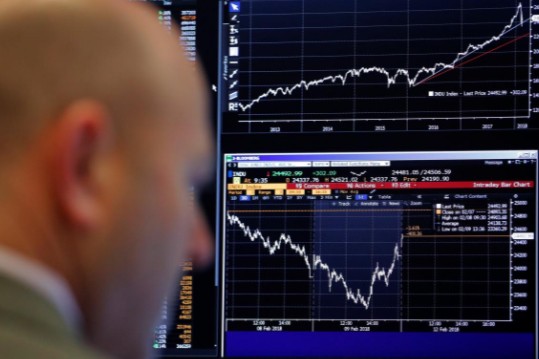
Wall Street surged on Wednesday as investors shrugged off stronger-than-expected inflation data and snapped up shares of Facebook, Amazon.com and Apple.
The fourth straight day of gains in the S&P 500 saw a return to the “fear of missing out” mentality that accompanied Wall Street’s rally in recent months ahead of a slump last week into correction territory.
Facebook (FB.O) jumped 3.7 percent while Amazon.com (AMZN.O) and Apple (AAPL.O) both rose more than 1.8 percent. All three fueled the S&P 500 more than any other shares, leaving the index up 1.34 percent for the session. They, along with Netflix (NFLX.O) and Alphabet (GOOGL.O) – collectively called the FAANG stocks – were major contributors to last year’s market rally, and all but Alphabet have weathered the recent selloff better than the broader market.
“FAANG is still working. And people feel that because they held up during the downturn, you can come back to them and not get hammered if things turn down again,” said Thomas Martin, senior portfolio manager at Globalt Investments in Atlanta, Georgia.
“There is still a fear of missing out.”
Since Thursday, the S&P 500 has surged 4.56 percent, its strongest four-session performance since mid-2016. The index remains down about 6 percent from its record high on Jan. 26.
The Labor Department’s core Consumer Price Index, which excludes the volatile food and energy components, increased 0.3 percent in January, while economists polled by Reuters had forecast an increase of 0.2 percent. However, the year-on-year rise was unchanged at 1.8 percent.
The data raised the specter of rising inflation and rekindled fears that the Federal Reserve could be forced to be more aggressive with interest rate increases.
But those inflation concerns were tempered by data showing U.S. retail sales fell 0.3 percent last month, the biggest decline in nearly a year and in sharp contrast to economists’ estimates for a 0.2 percent increase.
“The CPI shows there is some inflation, but it was not through the roof,” said Bruce Bittles, chief investment strategist at Robert W. Baird & Co in Nashville. “People got too pessimistic.”
Underpinning confidence among many investors is the belief that the U.S. economy remains strong and that tax cuts enacted this year will spur corporate earnings and lead consumers to spend more.
The Dow Jones Industrial Average .DJI jumped 1.03 percent to end at 24,893.49 while the S&P 500 .SPX rose 1.34 percent to finish at 2,698.63.
The Nasdaq Composite .IXIC surged 1.86 percent to 7,143.62.
Benchmark U.S. 10-year Treasury note yields US10YT=RR hit a four-year high, but a key measure of near-term volatility fell, in contrast to its reaction to strong U.S. jobs and wages data earlier in the month.
The CBOE Volatility index .VIX fell below 20 for the first time since Feb. 5.
The VIX slipping below 20 is “a very good sign”, said Bucky Hellwig, senior vice president at BB&T Wealth Management. “It shows the volatility is getting priced out of the market.”
Seven of the 11 major S&P 500 sectors rose, with financials .SPSY rising 2.32 percent and information technology .SPLRCT up 1.95 percent.
Fossil (FOSL.O) surged 87.7 percent after the watchmaker’s strong holiday-quarter sales and a rush among short-sellers to cover their positions.
Chipotle Mexican Grill (CMG.N) jumped 15.4 percent after it hired Brian Niccol from Taco Bell as its next chief executive, which analysts said sparked hopes of a quicker turnaround.
Advancing issues outnumbered declining ones on the NYSE by a 2.28-to-1 ratio; on Nasdaq, a 2.94-to-1 ratio favored advancers.
About 7.8 billion shares changed hands in U.S. exchanges, compared with the 8.4 billion daily average over the last 20 sessions.
